CIVE1155: Sustainable Home Design Project Report - Design and Analysis
VerifiedAdded on 2022/10/07
|11
|2333
|35
Report
AI Summary
This report details the design of a sustainable home, addressing key aspects such as land selection, passive design principles, and green building fundamentals. It considers factors like land orientation, size, and neighborhood character, emphasizing the importance of orientation and access for optimal design. The report outlines topological considerations, including family areas and exterior spaces, and discusses planning regulations and structural configurations. It highlights green building fundamentals such as energy conservation, water conservation through rainwater harvesting and reuse, and the selection of sustainable building materials. Climatic zones in Australia are considered, with a focus on Zone 7, and the report incorporates elements like energy-efficient appliances, ventilation heat recovery systems, and the use of water-based paints. The goal is to minimize environmental impact and maximize energy efficiency, aiming for a six-star energy rating and reduced water consumption. The design incorporates elements like grey water systems, solar hot water, and native landscaping, emphasizing a commitment to creating a carbon-neutral built environment.
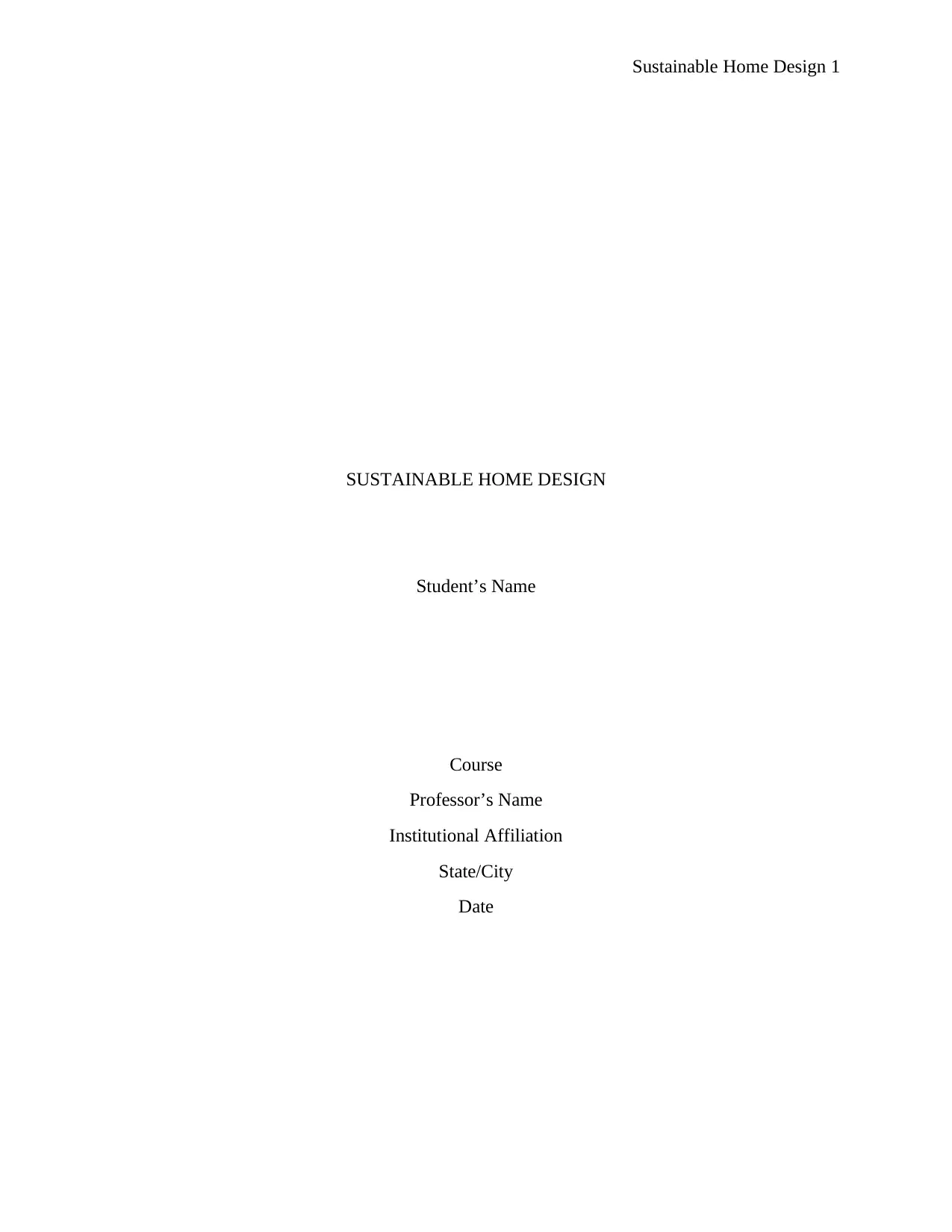
Sustainable Home Design 1
SUSTAINABLE HOME DESIGN
Student’s Name
Course
Professor’s Name
Institutional Affiliation
State/City
Date
SUSTAINABLE HOME DESIGN
Student’s Name
Course
Professor’s Name
Institutional Affiliation
State/City
Date
Paraphrase This Document
Need a fresh take? Get an instant paraphrase of this document with our AI Paraphraser
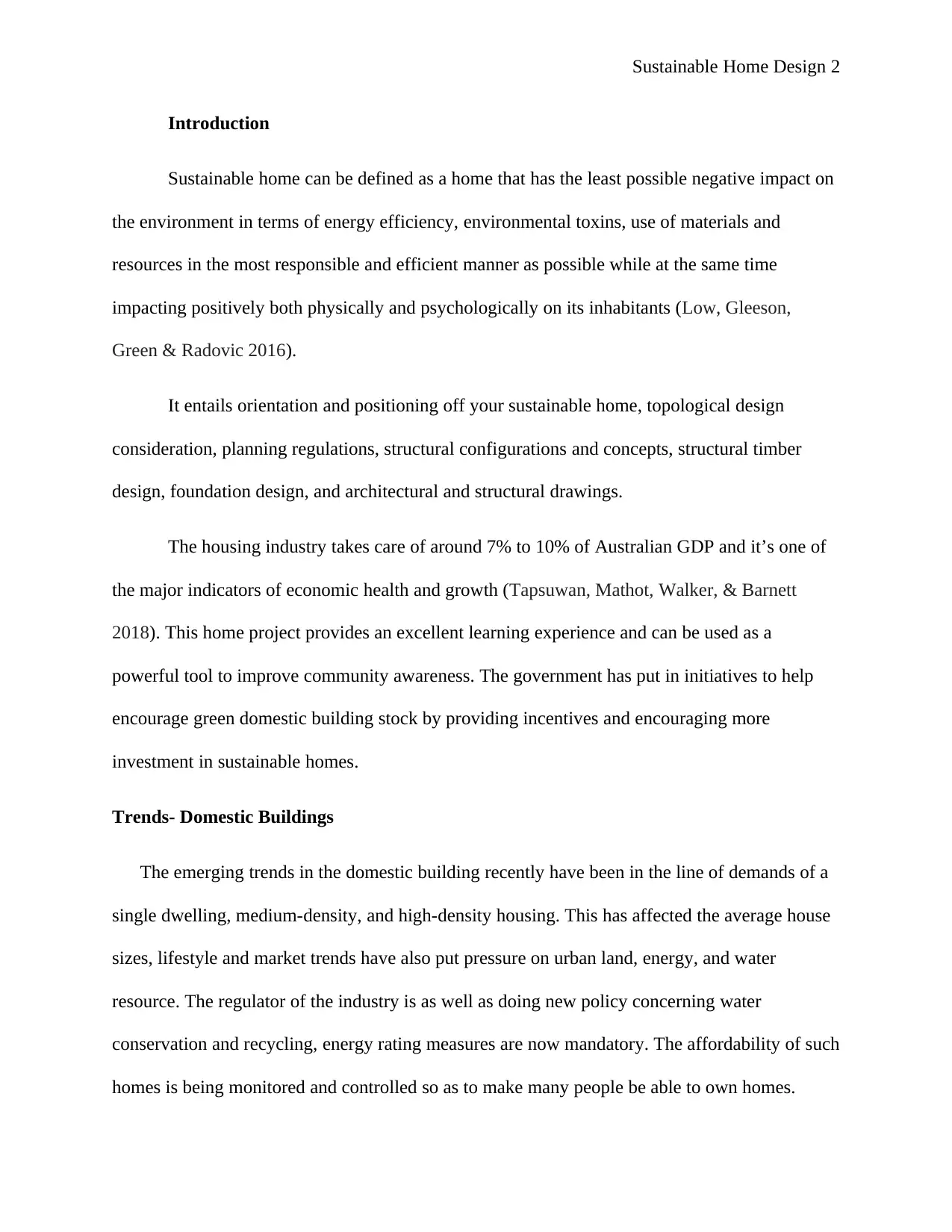
Sustainable Home Design 2
Introduction
Sustainable home can be defined as a home that has the least possible negative impact on
the environment in terms of energy efficiency, environmental toxins, use of materials and
resources in the most responsible and efficient manner as possible while at the same time
impacting positively both physically and psychologically on its inhabitants (Low, Gleeson,
Green & Radovic 2016).
It entails orientation and positioning off your sustainable home, topological design
consideration, planning regulations, structural configurations and concepts, structural timber
design, foundation design, and architectural and structural drawings.
The housing industry takes care of around 7% to 10% of Australian GDP and it’s one of
the major indicators of economic health and growth (Tapsuwan, Mathot, Walker, & Barnett
2018). This home project provides an excellent learning experience and can be used as a
powerful tool to improve community awareness. The government has put in initiatives to help
encourage green domestic building stock by providing incentives and encouraging more
investment in sustainable homes.
Trends- Domestic Buildings
The emerging trends in the domestic building recently have been in the line of demands of a
single dwelling, medium-density, and high-density housing. This has affected the average house
sizes, lifestyle and market trends have also put pressure on urban land, energy, and water
resource. The regulator of the industry is as well as doing new policy concerning water
conservation and recycling, energy rating measures are now mandatory. The affordability of such
homes is being monitored and controlled so as to make many people be able to own homes.
Introduction
Sustainable home can be defined as a home that has the least possible negative impact on
the environment in terms of energy efficiency, environmental toxins, use of materials and
resources in the most responsible and efficient manner as possible while at the same time
impacting positively both physically and psychologically on its inhabitants (Low, Gleeson,
Green & Radovic 2016).
It entails orientation and positioning off your sustainable home, topological design
consideration, planning regulations, structural configurations and concepts, structural timber
design, foundation design, and architectural and structural drawings.
The housing industry takes care of around 7% to 10% of Australian GDP and it’s one of
the major indicators of economic health and growth (Tapsuwan, Mathot, Walker, & Barnett
2018). This home project provides an excellent learning experience and can be used as a
powerful tool to improve community awareness. The government has put in initiatives to help
encourage green domestic building stock by providing incentives and encouraging more
investment in sustainable homes.
Trends- Domestic Buildings
The emerging trends in the domestic building recently have been in the line of demands of a
single dwelling, medium-density, and high-density housing. This has affected the average house
sizes, lifestyle and market trends have also put pressure on urban land, energy, and water
resource. The regulator of the industry is as well as doing new policy concerning water
conservation and recycling, energy rating measures are now mandatory. The affordability of such
homes is being monitored and controlled so as to make many people be able to own homes.
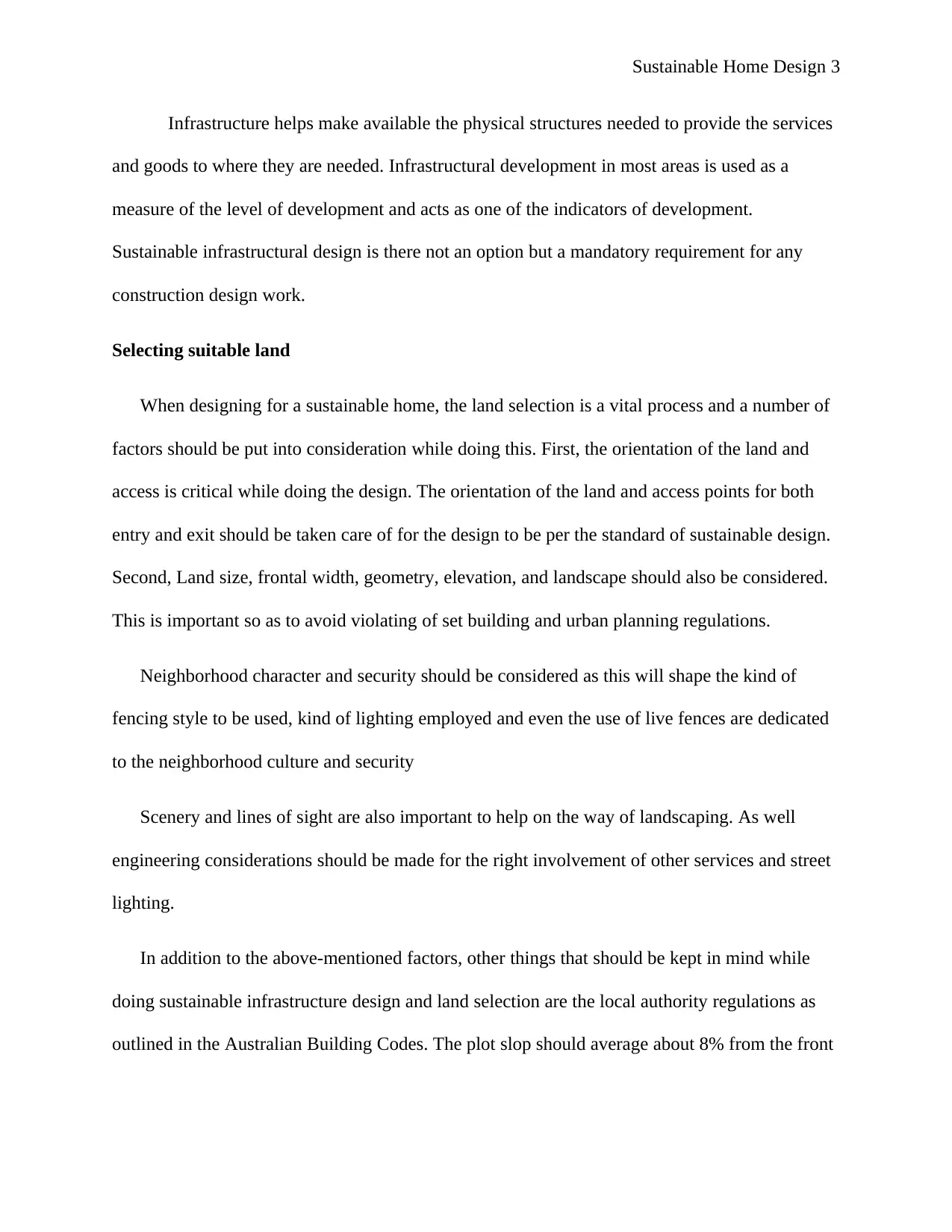
Sustainable Home Design 3
Infrastructure helps make available the physical structures needed to provide the services
and goods to where they are needed. Infrastructural development in most areas is used as a
measure of the level of development and acts as one of the indicators of development.
Sustainable infrastructural design is there not an option but a mandatory requirement for any
construction design work.
Selecting suitable land
When designing for a sustainable home, the land selection is a vital process and a number of
factors should be put into consideration while doing this. First, the orientation of the land and
access is critical while doing the design. The orientation of the land and access points for both
entry and exit should be taken care of for the design to be per the standard of sustainable design.
Second, Land size, frontal width, geometry, elevation, and landscape should also be considered.
This is important so as to avoid violating of set building and urban planning regulations.
Neighborhood character and security should be considered as this will shape the kind of
fencing style to be used, kind of lighting employed and even the use of live fences are dedicated
to the neighborhood culture and security
Scenery and lines of sight are also important to help on the way of landscaping. As well
engineering considerations should be made for the right involvement of other services and street
lighting.
In addition to the above-mentioned factors, other things that should be kept in mind while
doing sustainable infrastructure design and land selection are the local authority regulations as
outlined in the Australian Building Codes. The plot slop should average about 8% from the front
Infrastructure helps make available the physical structures needed to provide the services
and goods to where they are needed. Infrastructural development in most areas is used as a
measure of the level of development and acts as one of the indicators of development.
Sustainable infrastructural design is there not an option but a mandatory requirement for any
construction design work.
Selecting suitable land
When designing for a sustainable home, the land selection is a vital process and a number of
factors should be put into consideration while doing this. First, the orientation of the land and
access is critical while doing the design. The orientation of the land and access points for both
entry and exit should be taken care of for the design to be per the standard of sustainable design.
Second, Land size, frontal width, geometry, elevation, and landscape should also be considered.
This is important so as to avoid violating of set building and urban planning regulations.
Neighborhood character and security should be considered as this will shape the kind of
fencing style to be used, kind of lighting employed and even the use of live fences are dedicated
to the neighborhood culture and security
Scenery and lines of sight are also important to help on the way of landscaping. As well
engineering considerations should be made for the right involvement of other services and street
lighting.
In addition to the above-mentioned factors, other things that should be kept in mind while
doing sustainable infrastructure design and land selection are the local authority regulations as
outlined in the Australian Building Codes. The plot slop should average about 8% from the front
⊘ This is a preview!⊘
Do you want full access?
Subscribe today to unlock all pages.

Trusted by 1+ million students worldwide
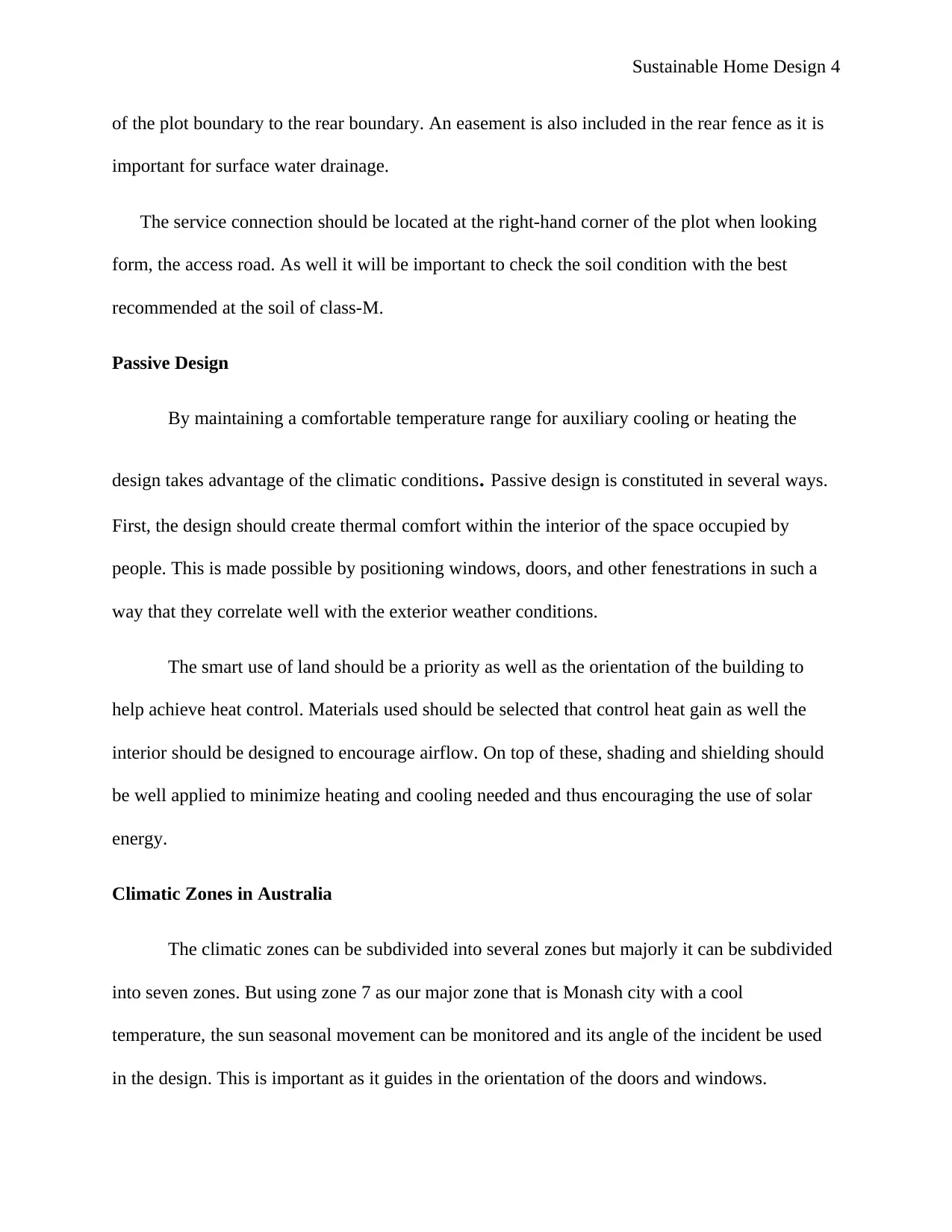
Sustainable Home Design 4
of the plot boundary to the rear boundary. An easement is also included in the rear fence as it is
important for surface water drainage.
The service connection should be located at the right-hand corner of the plot when looking
form, the access road. As well it will be important to check the soil condition with the best
recommended at the soil of class-M.
Passive Design
By maintaining a comfortable temperature range for auxiliary cooling or heating the
design takes advantage of the climatic conditions. Passive design is constituted in several ways.
First, the design should create thermal comfort within the interior of the space occupied by
people. This is made possible by positioning windows, doors, and other fenestrations in such a
way that they correlate well with the exterior weather conditions.
The smart use of land should be a priority as well as the orientation of the building to
help achieve heat control. Materials used should be selected that control heat gain as well the
interior should be designed to encourage airflow. On top of these, shading and shielding should
be well applied to minimize heating and cooling needed and thus encouraging the use of solar
energy.
Climatic Zones in Australia
The climatic zones can be subdivided into several zones but majorly it can be subdivided
into seven zones. But using zone 7 as our major zone that is Monash city with a cool
temperature, the sun seasonal movement can be monitored and its angle of the incident be used
in the design. This is important as it guides in the orientation of the doors and windows.
of the plot boundary to the rear boundary. An easement is also included in the rear fence as it is
important for surface water drainage.
The service connection should be located at the right-hand corner of the plot when looking
form, the access road. As well it will be important to check the soil condition with the best
recommended at the soil of class-M.
Passive Design
By maintaining a comfortable temperature range for auxiliary cooling or heating the
design takes advantage of the climatic conditions. Passive design is constituted in several ways.
First, the design should create thermal comfort within the interior of the space occupied by
people. This is made possible by positioning windows, doors, and other fenestrations in such a
way that they correlate well with the exterior weather conditions.
The smart use of land should be a priority as well as the orientation of the building to
help achieve heat control. Materials used should be selected that control heat gain as well the
interior should be designed to encourage airflow. On top of these, shading and shielding should
be well applied to minimize heating and cooling needed and thus encouraging the use of solar
energy.
Climatic Zones in Australia
The climatic zones can be subdivided into several zones but majorly it can be subdivided
into seven zones. But using zone 7 as our major zone that is Monash city with a cool
temperature, the sun seasonal movement can be monitored and its angle of the incident be used
in the design. This is important as it guides in the orientation of the doors and windows.
Paraphrase This Document
Need a fresh take? Get an instant paraphrase of this document with our AI Paraphraser
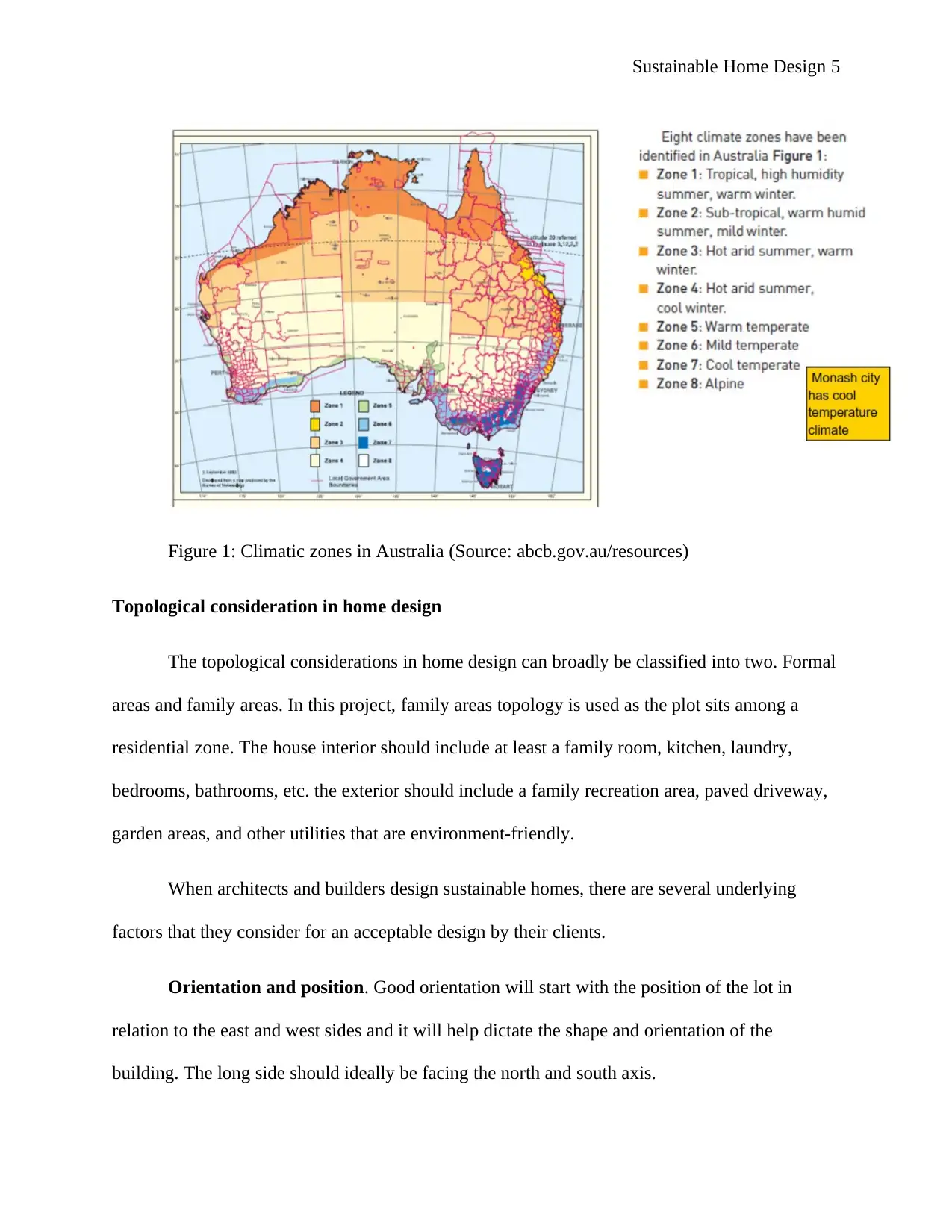
Sustainable Home Design 5
Figure 1: Climatic zones in Australia (Source: abcb.gov.au/resources)
Topological consideration in home design
The topological considerations in home design can broadly be classified into two. Formal
areas and family areas. In this project, family areas topology is used as the plot sits among a
residential zone. The house interior should include at least a family room, kitchen, laundry,
bedrooms, bathrooms, etc. the exterior should include a family recreation area, paved driveway,
garden areas, and other utilities that are environment-friendly.
When architects and builders design sustainable homes, there are several underlying
factors that they consider for an acceptable design by their clients.
Orientation and position. Good orientation will start with the position of the lot in
relation to the east and west sides and it will help dictate the shape and orientation of the
building. The long side should ideally be facing the north and south axis.
Figure 1: Climatic zones in Australia (Source: abcb.gov.au/resources)
Topological consideration in home design
The topological considerations in home design can broadly be classified into two. Formal
areas and family areas. In this project, family areas topology is used as the plot sits among a
residential zone. The house interior should include at least a family room, kitchen, laundry,
bedrooms, bathrooms, etc. the exterior should include a family recreation area, paved driveway,
garden areas, and other utilities that are environment-friendly.
When architects and builders design sustainable homes, there are several underlying
factors that they consider for an acceptable design by their clients.
Orientation and position. Good orientation will start with the position of the lot in
relation to the east and west sides and it will help dictate the shape and orientation of the
building. The long side should ideally be facing the north and south axis.
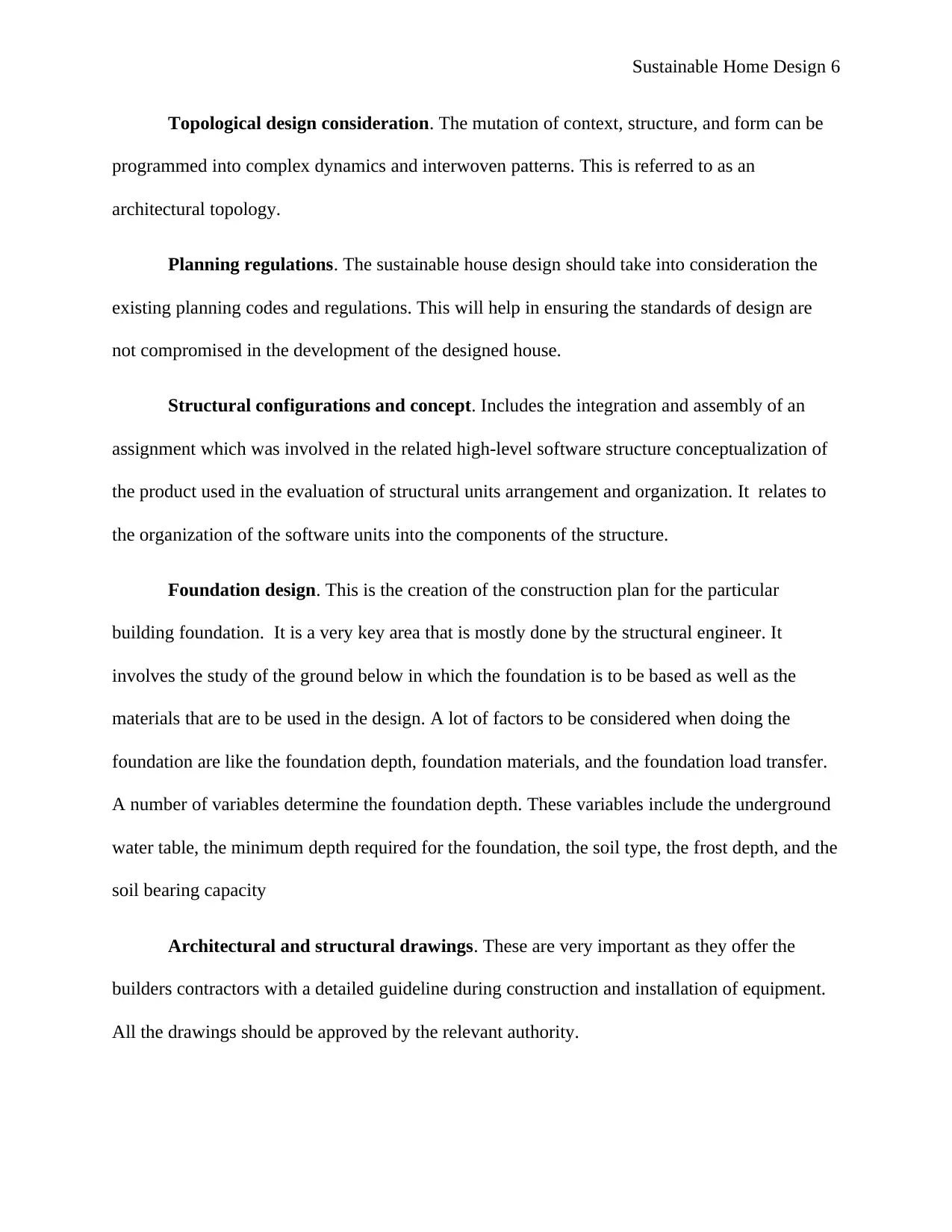
Sustainable Home Design 6
Topological design consideration. The mutation of context, structure, and form can be
programmed into complex dynamics and interwoven patterns. This is referred to as an
architectural topology.
Planning regulations. The sustainable house design should take into consideration the
existing planning codes and regulations. This will help in ensuring the standards of design are
not compromised in the development of the designed house.
Structural configurations and concept. Includes the integration and assembly of an
assignment which was involved in the related high-level software structure conceptualization of
the product used in the evaluation of structural units arrangement and organization. It relates to
the organization of the software units into the components of the structure.
Foundation design. This is the creation of the construction plan for the particular
building foundation. It is a very key area that is mostly done by the structural engineer. It
involves the study of the ground below in which the foundation is to be based as well as the
materials that are to be used in the design. A lot of factors to be considered when doing the
foundation are like the foundation depth, foundation materials, and the foundation load transfer.
A number of variables determine the foundation depth. These variables include the underground
water table, the minimum depth required for the foundation, the soil type, the frost depth, and the
soil bearing capacity
Architectural and structural drawings. These are very important as they offer the
builders contractors with a detailed guideline during construction and installation of equipment.
All the drawings should be approved by the relevant authority.
Topological design consideration. The mutation of context, structure, and form can be
programmed into complex dynamics and interwoven patterns. This is referred to as an
architectural topology.
Planning regulations. The sustainable house design should take into consideration the
existing planning codes and regulations. This will help in ensuring the standards of design are
not compromised in the development of the designed house.
Structural configurations and concept. Includes the integration and assembly of an
assignment which was involved in the related high-level software structure conceptualization of
the product used in the evaluation of structural units arrangement and organization. It relates to
the organization of the software units into the components of the structure.
Foundation design. This is the creation of the construction plan for the particular
building foundation. It is a very key area that is mostly done by the structural engineer. It
involves the study of the ground below in which the foundation is to be based as well as the
materials that are to be used in the design. A lot of factors to be considered when doing the
foundation are like the foundation depth, foundation materials, and the foundation load transfer.
A number of variables determine the foundation depth. These variables include the underground
water table, the minimum depth required for the foundation, the soil type, the frost depth, and the
soil bearing capacity
Architectural and structural drawings. These are very important as they offer the
builders contractors with a detailed guideline during construction and installation of equipment.
All the drawings should be approved by the relevant authority.
⊘ This is a preview!⊘
Do you want full access?
Subscribe today to unlock all pages.

Trusted by 1+ million students worldwide
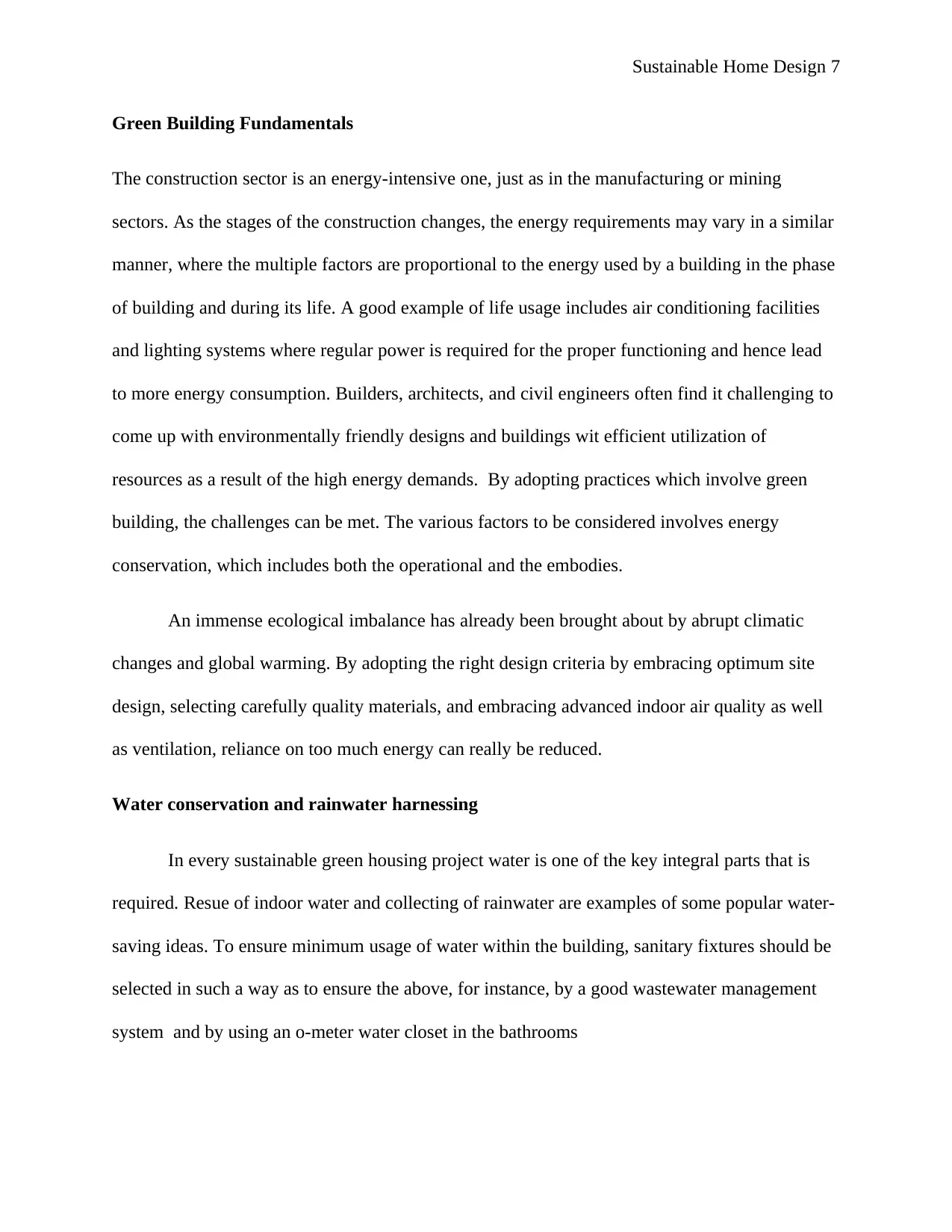
Sustainable Home Design 7
Green Building Fundamentals
The construction sector is an energy-intensive one, just as in the manufacturing or mining
sectors. As the stages of the construction changes, the energy requirements may vary in a similar
manner, where the multiple factors are proportional to the energy used by a building in the phase
of building and during its life. A good example of life usage includes air conditioning facilities
and lighting systems where regular power is required for the proper functioning and hence lead
to more energy consumption. Builders, architects, and civil engineers often find it challenging to
come up with environmentally friendly designs and buildings wit efficient utilization of
resources as a result of the high energy demands. By adopting practices which involve green
building, the challenges can be met. The various factors to be considered involves energy
conservation, which includes both the operational and the embodies.
An immense ecological imbalance has already been brought about by abrupt climatic
changes and global warming. By adopting the right design criteria by embracing optimum site
design, selecting carefully quality materials, and embracing advanced indoor air quality as well
as ventilation, reliance on too much energy can really be reduced.
Water conservation and rainwater harnessing
In every sustainable green housing project water is one of the key integral parts that is
required. Resue of indoor water and collecting of rainwater are examples of some popular water-
saving ideas. To ensure minimum usage of water within the building, sanitary fixtures should be
selected in such a way as to ensure the above, for instance, by a good wastewater management
system and by using an o-meter water closet in the bathrooms
Green Building Fundamentals
The construction sector is an energy-intensive one, just as in the manufacturing or mining
sectors. As the stages of the construction changes, the energy requirements may vary in a similar
manner, where the multiple factors are proportional to the energy used by a building in the phase
of building and during its life. A good example of life usage includes air conditioning facilities
and lighting systems where regular power is required for the proper functioning and hence lead
to more energy consumption. Builders, architects, and civil engineers often find it challenging to
come up with environmentally friendly designs and buildings wit efficient utilization of
resources as a result of the high energy demands. By adopting practices which involve green
building, the challenges can be met. The various factors to be considered involves energy
conservation, which includes both the operational and the embodies.
An immense ecological imbalance has already been brought about by abrupt climatic
changes and global warming. By adopting the right design criteria by embracing optimum site
design, selecting carefully quality materials, and embracing advanced indoor air quality as well
as ventilation, reliance on too much energy can really be reduced.
Water conservation and rainwater harnessing
In every sustainable green housing project water is one of the key integral parts that is
required. Resue of indoor water and collecting of rainwater are examples of some popular water-
saving ideas. To ensure minimum usage of water within the building, sanitary fixtures should be
selected in such a way as to ensure the above, for instance, by a good wastewater management
system and by using an o-meter water closet in the bathrooms
Paraphrase This Document
Need a fresh take? Get an instant paraphrase of this document with our AI Paraphraser
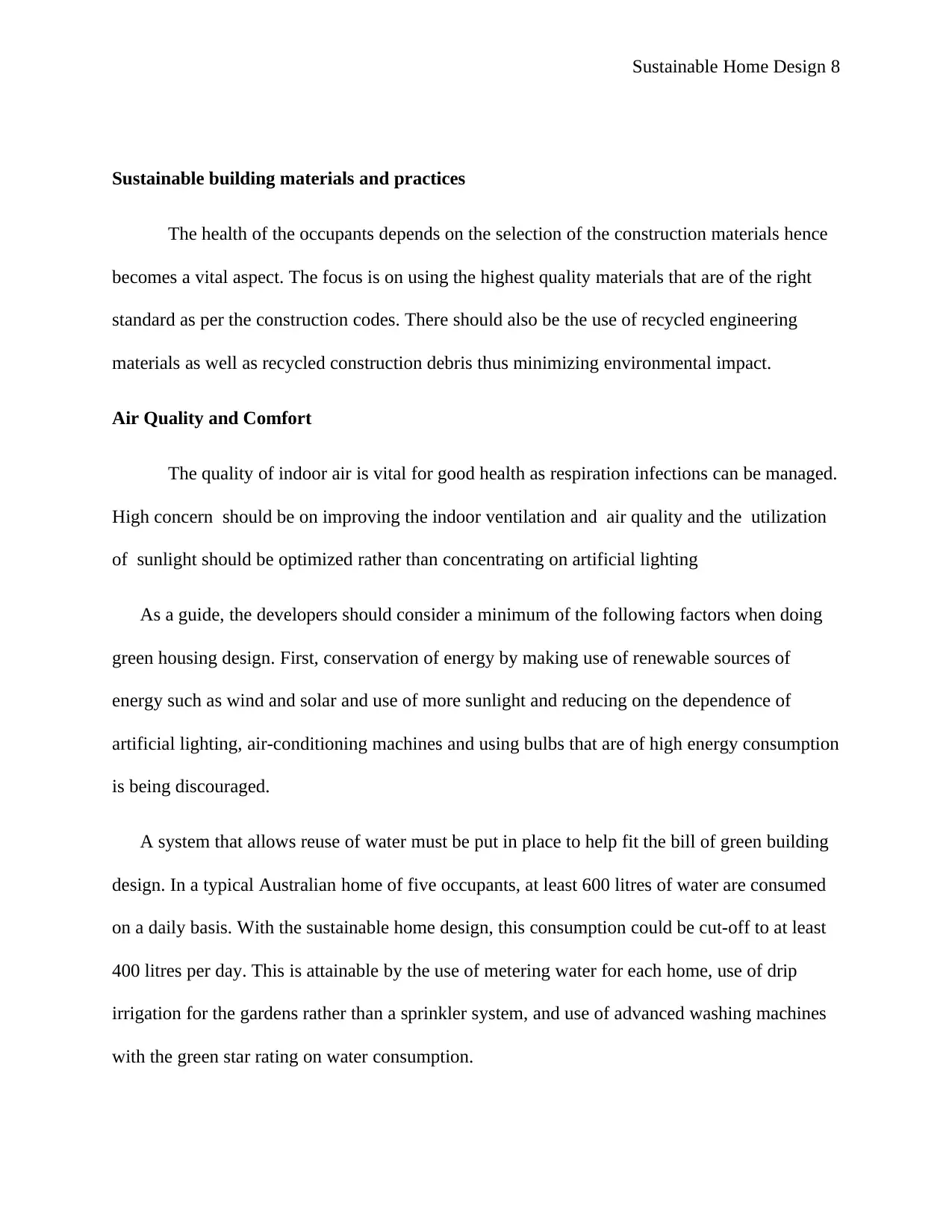
Sustainable Home Design 8
Sustainable building materials and practices
The health of the occupants depends on the selection of the construction materials hence
becomes a vital aspect. The focus is on using the highest quality materials that are of the right
standard as per the construction codes. There should also be the use of recycled engineering
materials as well as recycled construction debris thus minimizing environmental impact.
Air Quality and Comfort
The quality of indoor air is vital for good health as respiration infections can be managed.
High concern should be on improving the indoor ventilation and air quality and the utilization
of sunlight should be optimized rather than concentrating on artificial lighting
As a guide, the developers should consider a minimum of the following factors when doing
green housing design. First, conservation of energy by making use of renewable sources of
energy such as wind and solar and use of more sunlight and reducing on the dependence of
artificial lighting, air-conditioning machines and using bulbs that are of high energy consumption
is being discouraged.
A system that allows reuse of water must be put in place to help fit the bill of green building
design. In a typical Australian home of five occupants, at least 600 litres of water are consumed
on a daily basis. With the sustainable home design, this consumption could be cut-off to at least
400 litres per day. This is attainable by the use of metering water for each home, use of drip
irrigation for the gardens rather than a sprinkler system, and use of advanced washing machines
with the green star rating on water consumption.
Sustainable building materials and practices
The health of the occupants depends on the selection of the construction materials hence
becomes a vital aspect. The focus is on using the highest quality materials that are of the right
standard as per the construction codes. There should also be the use of recycled engineering
materials as well as recycled construction debris thus minimizing environmental impact.
Air Quality and Comfort
The quality of indoor air is vital for good health as respiration infections can be managed.
High concern should be on improving the indoor ventilation and air quality and the utilization
of sunlight should be optimized rather than concentrating on artificial lighting
As a guide, the developers should consider a minimum of the following factors when doing
green housing design. First, conservation of energy by making use of renewable sources of
energy such as wind and solar and use of more sunlight and reducing on the dependence of
artificial lighting, air-conditioning machines and using bulbs that are of high energy consumption
is being discouraged.
A system that allows reuse of water must be put in place to help fit the bill of green building
design. In a typical Australian home of five occupants, at least 600 litres of water are consumed
on a daily basis. With the sustainable home design, this consumption could be cut-off to at least
400 litres per day. This is attainable by the use of metering water for each home, use of drip
irrigation for the gardens rather than a sprinkler system, and use of advanced washing machines
with the green star rating on water consumption.
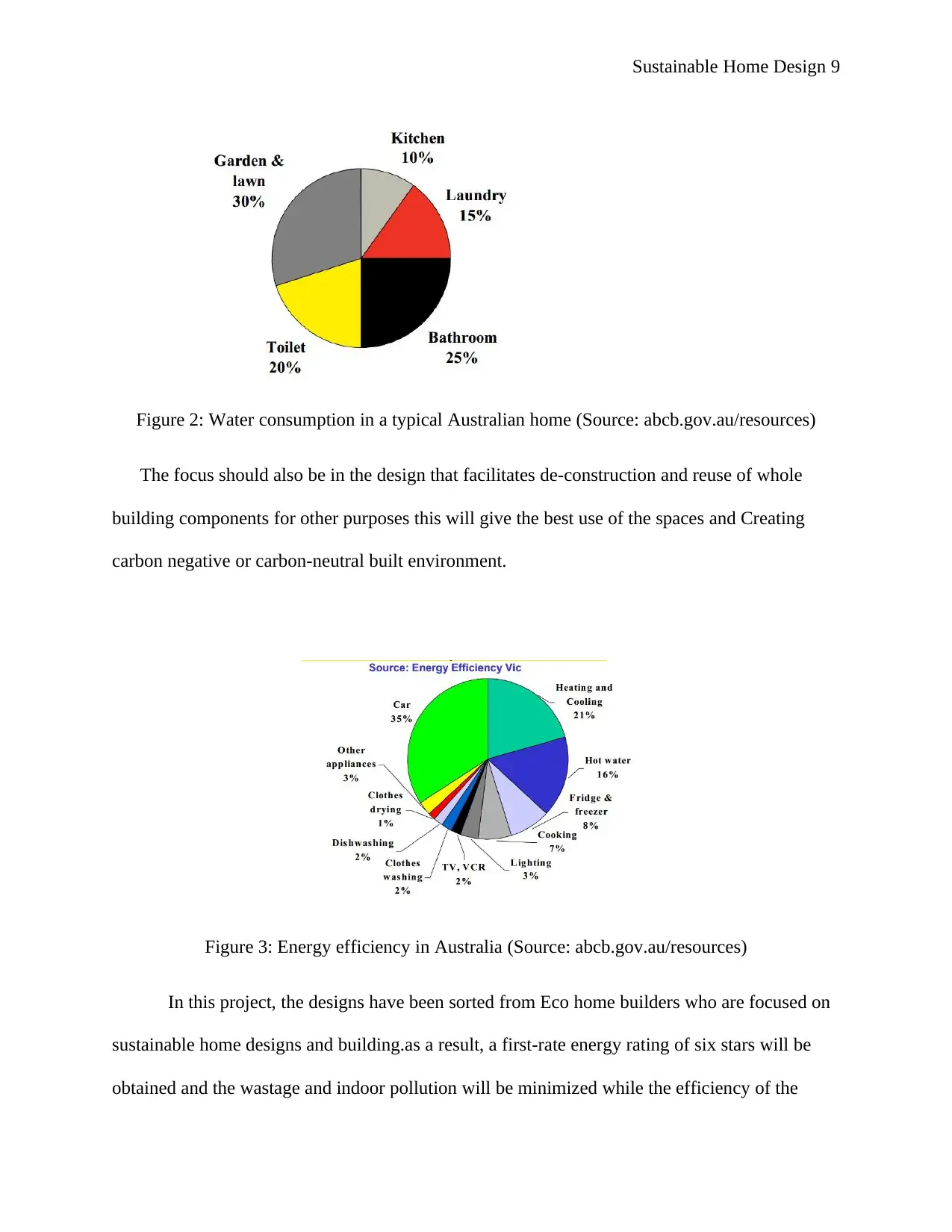
Sustainable Home Design 9
Figure 2: Water consumption in a typical Australian home (Source: abcb.gov.au/resources)
The focus should also be in the design that facilitates de-construction and reuse of whole
building components for other purposes this will give the best use of the spaces and Creating
carbon negative or carbon-neutral built environment.
Figure 3: Energy efficiency in Australia (Source: abcb.gov.au/resources)
In this project, the designs have been sorted from Eco home builders who are focused on
sustainable home designs and building.as a result, a first-rate energy rating of six stars will be
obtained and the wastage and indoor pollution will be minimized while the efficiency of the
Figure 2: Water consumption in a typical Australian home (Source: abcb.gov.au/resources)
The focus should also be in the design that facilitates de-construction and reuse of whole
building components for other purposes this will give the best use of the spaces and Creating
carbon negative or carbon-neutral built environment.
Figure 3: Energy efficiency in Australia (Source: abcb.gov.au/resources)
In this project, the designs have been sorted from Eco home builders who are focused on
sustainable home designs and building.as a result, a first-rate energy rating of six stars will be
obtained and the wastage and indoor pollution will be minimized while the efficiency of the
⊘ This is a preview!⊘
Do you want full access?
Subscribe today to unlock all pages.

Trusted by 1+ million students worldwide
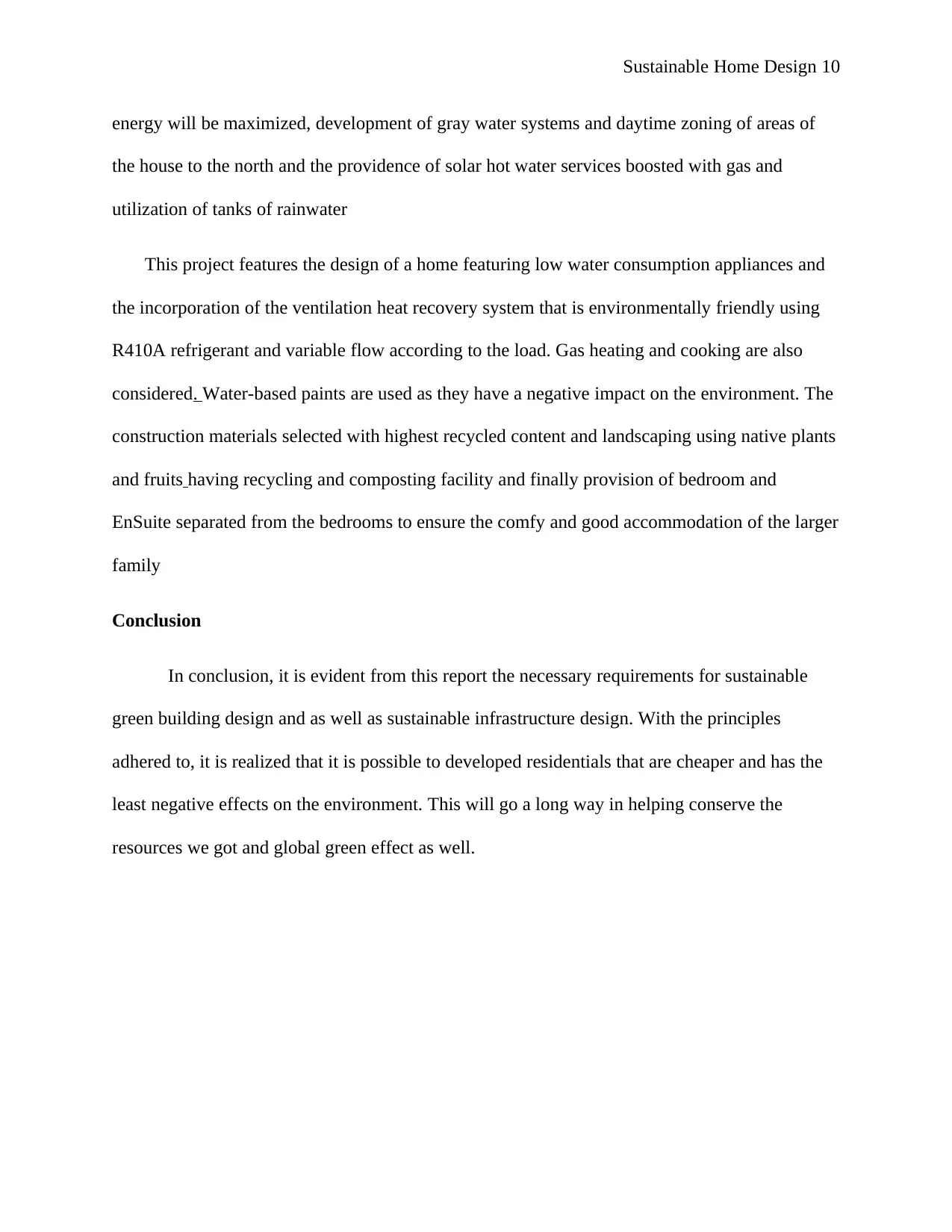
Sustainable Home Design 10
energy will be maximized, development of gray water systems and daytime zoning of areas of
the house to the north and the providence of solar hot water services boosted with gas and
utilization of tanks of rainwater
This project features the design of a home featuring low water consumption appliances and
the incorporation of the ventilation heat recovery system that is environmentally friendly using
R410A refrigerant and variable flow according to the load. Gas heating and cooking are also
considered. Water-based paints are used as they have a negative impact on the environment. The
construction materials selected with highest recycled content and landscaping using native plants
and fruits having recycling and composting facility and finally provision of bedroom and
EnSuite separated from the bedrooms to ensure the comfy and good accommodation of the larger
family
Conclusion
In conclusion, it is evident from this report the necessary requirements for sustainable
green building design and as well as sustainable infrastructure design. With the principles
adhered to, it is realized that it is possible to developed residentials that are cheaper and has the
least negative effects on the environment. This will go a long way in helping conserve the
resources we got and global green effect as well.
energy will be maximized, development of gray water systems and daytime zoning of areas of
the house to the north and the providence of solar hot water services boosted with gas and
utilization of tanks of rainwater
This project features the design of a home featuring low water consumption appliances and
the incorporation of the ventilation heat recovery system that is environmentally friendly using
R410A refrigerant and variable flow according to the load. Gas heating and cooking are also
considered. Water-based paints are used as they have a negative impact on the environment. The
construction materials selected with highest recycled content and landscaping using native plants
and fruits having recycling and composting facility and finally provision of bedroom and
EnSuite separated from the bedrooms to ensure the comfy and good accommodation of the larger
family
Conclusion
In conclusion, it is evident from this report the necessary requirements for sustainable
green building design and as well as sustainable infrastructure design. With the principles
adhered to, it is realized that it is possible to developed residentials that are cheaper and has the
least negative effects on the environment. This will go a long way in helping conserve the
resources we got and global green effect as well.
Paraphrase This Document
Need a fresh take? Get an instant paraphrase of this document with our AI Paraphraser
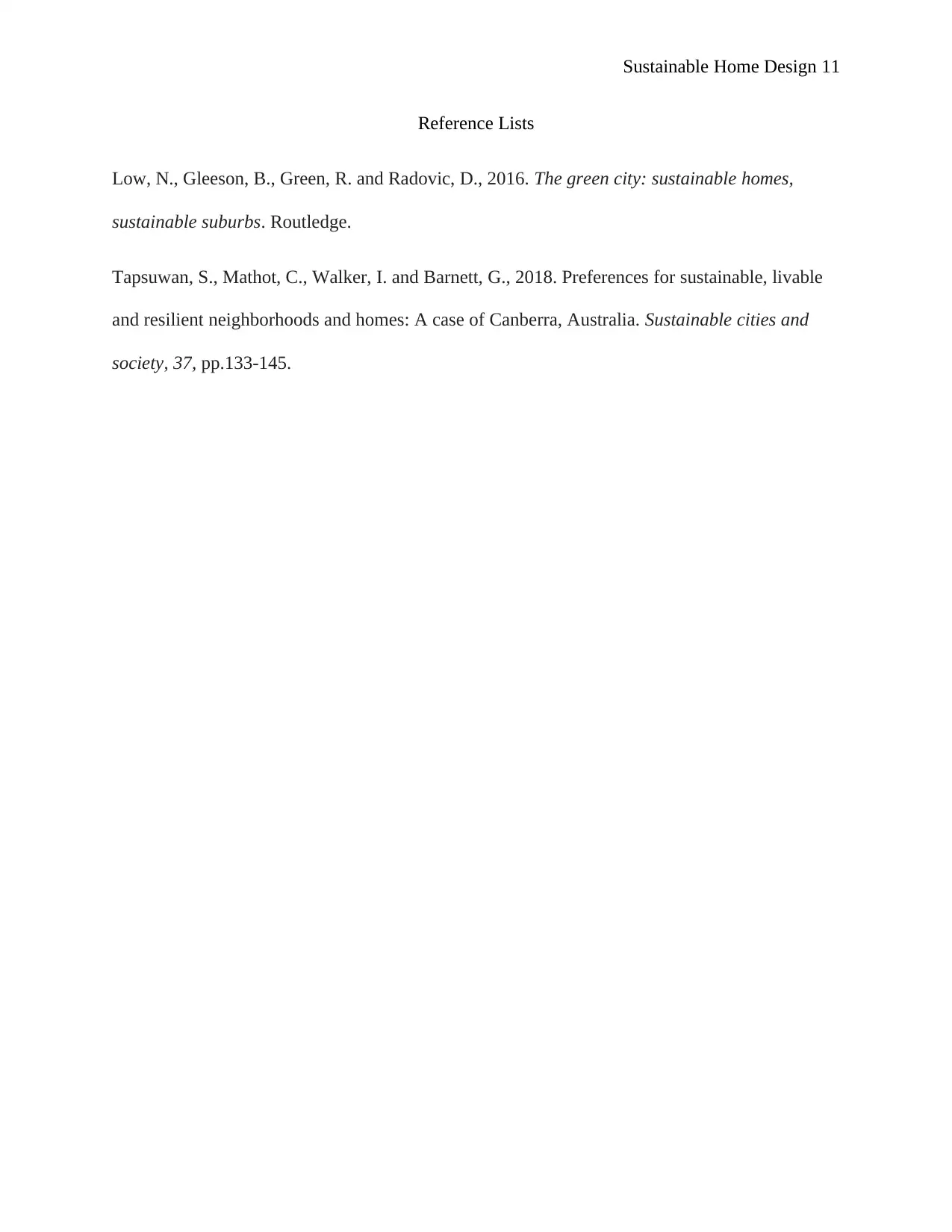
Sustainable Home Design 11
Reference Lists
Low, N., Gleeson, B., Green, R. and Radovic, D., 2016. The green city: sustainable homes,
sustainable suburbs. Routledge.
Tapsuwan, S., Mathot, C., Walker, I. and Barnett, G., 2018. Preferences for sustainable, livable
and resilient neighborhoods and homes: A case of Canberra, Australia. Sustainable cities and
society, 37, pp.133-145.
Reference Lists
Low, N., Gleeson, B., Green, R. and Radovic, D., 2016. The green city: sustainable homes,
sustainable suburbs. Routledge.
Tapsuwan, S., Mathot, C., Walker, I. and Barnett, G., 2018. Preferences for sustainable, livable
and resilient neighborhoods and homes: A case of Canberra, Australia. Sustainable cities and
society, 37, pp.133-145.
1 out of 11
Related Documents
Your All-in-One AI-Powered Toolkit for Academic Success.
+13062052269
info@desklib.com
Available 24*7 on WhatsApp / Email
![[object Object]](/_next/static/media/star-bottom.7253800d.svg)
Unlock your academic potential
Copyright © 2020–2025 A2Z Services. All Rights Reserved. Developed and managed by ZUCOL.





